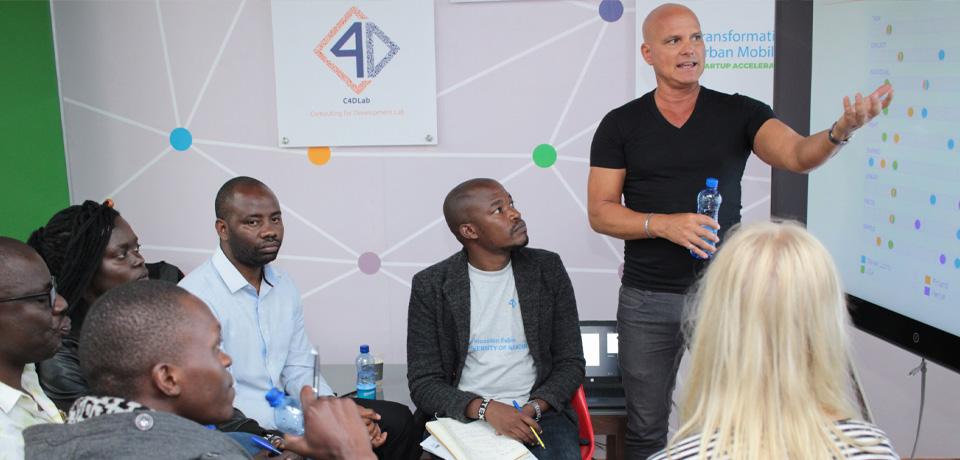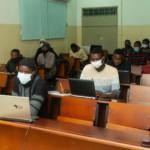
Bubala Thandie Hamaimbo, Eva Nambeye, Bernard Himoonga Moonga, Basil Mugonola, Emmanuel Chibanda Musaba, Satu Määttänen & Eija Laitinen
Higher education should be responsive to the changing world and societies’ needs and produce empowered graduates with transferrable skills and abilities for lifelong learning (Harvey, 2000; Immordino-Yang, 2015). Rapid technological development and subsequent changes and variabilities in learners and in world of work needs are questioning the suitability of traditional, teacher-driven, teaching methods in order to develop the competencies needed in the 21st century (Paramasivan, 2015).
Traditional educational setup, emphasizing lectures and content focus (Gourlay, 2015), can be operated with high student numbers and limited staff and time resources (Drysdale et al., 2020). However, these methods ignore differences in students’ pre-knowledge and interests and undermine opportunities for questioning and reasoning. Within traditional methods, whether in a classroom or the field, students often have pressure to complete assignments and experiments with the correct result by mimicking and following instructions. Students may leave the learning situation having learned only to mechanically follow steps and memorize, without opportunities to explore nor fully understand or achieve the learning outcomes of the experience (Drysdale et al., 2020).
Insufficient learning outcomes, coupled with growing attrition rates, have ignited the development and adoption of alternative teaching methods that meet the various and variable needs of learners (Haggis, 2006). New frameworks in learning and teaching value diversity, incorporating a variety of pedagogical approaches to engage learners (La et al., 2018). Working together with industries is one approach to bring practicality into learning, enabling students to get experience from and contacts to working life while working with relevant, real-life tasks.
University-industry collaboration
University-industry collaboration (UIC) can be understood as an interaction between higher education institutes (HEIs) and industry to combine material, intellectual or other resources for a common objective (Siegel, 2010). UIC can take different forms and be built upon various motives (Ankrah & AL-Tabbaa, 2015). For industry, growing needs for innovation, new products and human capital, creates incentives to interact with academic institutions (Ankrah & AL-Tabbaa, 2015). For universities, a shortage of funding, desire to demonstrate the relevance and provision of authentic learning experiences and better employment prospects for graduates are some of the reasons pushing them into collaboration (Ankrah & AL-Tabbaa, 2015). Study programmes should be better aligned with the evolving practical needs of industries (Bevanda et al., 2014) and UIC is an efficient method in order to incorporate the industry needs into academic curricula. In addition, UIC has been identified as one of the key factors for improving the rate and speed of knowledge generation and transfer, and the subsequent positive outcomes (Philbin, 2008; Wodehouse & Mendibil, 2013).
Whereas within the developed world UIC has a strong status, in the developing world, it is still in its infancy. Most universities in sub-Saharan Africa do not have well-developed UIC schemes. The collaboration is mostly limited to internships, student placements and apprenticeships. We suggest incorporating problem-based learning into study programmes to widen the prospects for sustainable collaboration and to strengthen the university’s ties to industry.
The emergence of problem-based learning
Problem-based learning (PBL) was first developed for medical studies (Albanese & Mitchell, 1993). From there it has been mainstreamed in multiple disciplines. The aim of aligning education with professional practices has been one of the driving forces triggering the move toward PBL (Jensen & Strømsø, 2019).
In PBL, learners acquire knowledge and skills by encountering real-life situations and challenges. The relevance, real-world context, creates a stimulus for learning and motivation. Applying and deriving from the emerging understanding about neuroscience to social psychology, PBL emphasizes active, student-directed learning.
Academic evidence suggests that PBL has several advantages over the traditional teaching and learning systems. PBL has been attributed to enhanced critical thinking and collaboration skills and the development of life-long learners with the flexibility to apply knowledge for solving various problems (Kim, 2014; Lim, 2012; Wood, 2003).
Synergistic benefits through PBL and UIC
Collaborating with industry partners within PBL is important for students’ learning. Industry provides authentic problems or cases for students to work with, allowing students to develop competencies relevant to employment (Lima et al., 2017; Tamaki et al., 2019). In addition, real-life context and contacts are expected to improve students’ motivation and engagement to peer-community. Industry, in turn, will get access to human capital and university resources, and assistance in solving challenges they face.
The benefits of university-industry collaboration within the PBL context can be summarized as follows:
- The industry will have a great opportunity to work closely with students and source potential future employees (Ankrah & AL-Tabbaa, 2015).
- Students will have an opportunity to see different realities outside the classroom, giving them a chance to “practice the professional practice” and use machinery not necessarily available in universities. (Lima et al., 2017).
- Integrating UIC into curricula enables students to develop working life relevant competencies and networks.
- Through collaboration, universities and industries may find solutions to wider socio-economic, political, developmental or ecological challenges.
Building sustainable university-industry collaboration
UIC and new teaching methods, such as PBL, do not evolve themselves but their establishment and maintenance require effort and may pose challenges.
Individual HEI staff members, the main initiators of UIC (Awasthy et al., 2020), may not have enough time and capacity to identify potential industry partners and formalize collaborations. Thus, management staff should provide guidance, incentives and structures for starting up UIC.
Maintaining UIC requires time and resource commitment. PBL is associated with higher financial costs compared with lecture-based teaching, due to increased time, space, transport and facility requirements (Hamdy & Agamy, 2011). This may be especially constraining to developing country HEIs that already struggle with limited resources. To enable sustainable collaboration schemes through PBL, these should be mainstreamed in the formal HEI budget.
It may be challenging to maintain communication and facilitate different types of learners and industry partners in PBL. HEI staff members must gain adequate support and training opportunities for manoeuvring PBL and frequent communication with the industry (AlBuali & Khan, 2018). Curricula should be flexible to accommodate different teaching styles and to enable adapting to industry working methods.
The cornerstone of sustainable UIC is reciprocity; HEI and industry partners need to provide effort and resources, but also receive equal benefits. Realistic objectives need to be set and stakeholders should be aware of what is expected of them and what they are expected to gain.
Conclusions
Today’s students will face complex challenges after graduation. Knowing how to solve problems, work collaboratively, and think innovatively are becoming essential skills, not only for finding future careers but also for tackling local and global challenges. Traditional training methods are losing their importance due to the industries’ and societies’ demand for higher education relevancy and a new set of 21st-century competencies. Education systems need to reform to be responsive to the rapidly changing world and produce lifelong learners that can adjust and take advantage of technological development.
PBL, combined with close collaboration with the industry, has the potential to develop competent graduates ready to step into the world of work, while simultaneously creating various other benefits. By working together, students, the whole university and the industry can contribute to innovations, products and solutions. To ensure sustainable collaboration with PBL, there is a need for institutionalizing IUC through adequate budgeting, curricula reforms and deliberate efforts to bring the industry closer to the universities.
This article has been written as part of a professional Problem-Based Learning Training Programme for East and Southern African university teachers. The training programme was organized as part of AgriSCALE project (https://www.agriscale.net/) activities during 2021. AgriSCALE is an EU-funded project coordinated by Häme University of Applied Sciences (FIN), that aims to reform agricultural education and curricula in East and Southern African universities. Project partners include nine universities from East and Southern Africa and Europe.
Authors
Bubala Thandie Hamaimbo, MSc. in human nutrition, lecturer and assistant dean in the School of Agricultural Sciences at the University of Zambia.
Eva Nambeye, MSc. in aquaculture, lecturer-researcher and consultant in the department of Animal Sciences, at the University of Zambia.
Bernard Himoonga Moonga, PhD in Food Science & Technology, Lecturer and Partnerships & Outreach Coordinator for the School of Agricultural Sciences at the University of Zambia.
Basil Mugonola, is an associate professor in the faculty of agriculture and Environment, Gulu University with a PhD in Bio-Science Engineering from the Catholic University of Leuven, Belgium. He is the local coordinator of the AgriSCALE project at Gulu University.
Emmanuel Chibanda Musaba (Ph. D. Agric Econ, USASK, Canada) is a Senior Lecturer and Head of Agricultural Economics and Agribusiness Department in the School of Agriculture and Natural Resources at Mulungushi University, Kabwe, Zambia. He is the local Coordinator of the AgriSCALE Project.
Satu Määttänen, M.Sc. in Agr. & For. and M.Sc. in Biol & Env. Sci. Research Assistant in Häme University of Applied Sciences at Bio Research Unit.
Eija Laitinen, PhD in Adult Education, Principal Research Scientist in HAMK Bio Research Unit AgriSCALE and PBL-BioAfrica Project Coordinator and leader of the HAMK Africa Team.
References
Albanese, M. A. & Mitchell, S. (1993). Problem-based learning: a review of literature on its outcomes and implementation issues. Academic Medicine, 68(1), 52–81. https://doi.org/10.1097/00001888-199301000-00012
AlBuali, W. H. & Khan, A. S. (2018). Challenges Facing the Shift from the Conventional to Problem-Based Learning Curriculum. Higher Education Studies, 8(1), 36–41. https://eric.ed.gov/?id=EJ1169374
Ankrah, S. & AL-Tabbaa, O. (2015). Universities-industry collaboration: A systematic review. Scandinavian Journal of Management, 31(3), 387–408. https://doi.org/https://doi.org/10.1016/j.scaman.2015.02.003
Awasthy, R., Flint, S., Sankarnarayana, R. & Jones, R. L. (2020). A framework to improve university–industry collaboration. Journal of Industry-University Collaboration, 2(1), 49–62. https://doi.org/10.1108/JIUC-09-2019-0016
Bevanda, V., Brenko, D. & Frankovic, P. (2014). University-Industry Collaboration: A Case Study of Enhancing the Quality of Information Technology Education. In L. G. Chova, L. Martinez & C. Torres (Eds.), INTED2014 Proceedings. 8th International Technology, Education and Development Conference (pp. 252–261). IATED Academy.
Drysdale, T. D., Kelley, S., Scott, A. M., Dishon, V., Weightman, A., Lewis, R. J. & Watts, S. (2020). Opinion piece: non-traditional practical work for traditional campuses. Higher Education Pedagogies, 5(1), 210–222. https://doi.org/10.1080/23752696.2020.1816845
Gourlay, L. (2015). ‘Student engagement’ and the tyranny of participation. Teaching in Higher Education, 20(4), 402–411. https://doi.org/10.1080/13562517.2015.1020784
Haggis, T. (2006). Pedagogies for diversity: Retaining critical challenge amidst fears of “dumbing down.” Studies in Higher Education, 31(5), 521–535. https://doi.org/10.1080/03075070600922709
Hamdy, H. & Agamy, E. (2011). Is running a problem-based learning curriculum more expensive than a traditional Subject-Based Curriculum? Medical Teacher, 33(9), e509-14. https://doi.org/10.3109/0142159X.2011.599451
Harvey, L. (2000). New Realities: The Relationship between Higher Education and Employment. Tertiary Education and Management 2000 6:1, 6(1), 3–17. https://doi.org/10.1023/A:1009685205201
Immordino-Yang, M. H. (2015). Emotions, learning, and the brain : exploring the educational implications of affective neuroscience. W. W. Norton & Company.
Jensen, K. & Strømsø, H. I. (2019). Problem-Based Learning: the Emergence of New Scripts and Roles for Teachers to Render Epistemic Practices Transparent. Vocations and Learning, 12(3), 343–360. https://doi.org/10.1007/S12186-018-09215-8
Kim, D. Y. (2014). Adopting Problem-Based Learning in Criminology and Criminal Justice Education: Challenge and Response. SAGE Open, 4(3), 215824401454208. https://doi.org/10.1177/2158244014542086
La, H., Dyjur, P. & Bair, H. (2018). Universal Design for Learning in Higher Education. Taylor
Institute for Teaching and Learning. University of Calgary.
Lim, W. K. (2012). Dysfunctional problem-based learning curricula: Resolving the problem. BMC Medical Education, 12(1), 89. https://doi.org/10.1186/1472-6920-12-89
Lima, R. M., Dinis-Carvalho, J., Sousa, R. M., Arezes, P. & Mesquita, D. (2017). Development of competences while solving real industrial interdisciplinary problems: A successful cooperation with industry. Production, 27(spe), e20162300. https://doi.org/10.1590/0103-6513.230016
Paramasivan, C. (2015). Conventional Methods of Training to Teacher and its Impact in Higher Education. International Journal of Advanced Scientific Research & Development, 2(4), 1–9.
Philbin, S. (2008). Process model for university-industry research collaboration. European Journal of Innovation Management, 11(4), 488–521. https://doi.org/10.1108/14601060810911138
Siegel, D. J. (2010). Organizing for social partnership : higher education in cross-sector collaboration. Routledge.
Tamaki, K., Arakawa, M., Arame, M. & Ono, Y. (2019). Development of Educational Programs for System Creators and Business Producers in Future Strategy Design Based on Action Project Group Activities through Industry-University Cooperation. Procedia Manufacturing, 39, 1377–1382. https://doi.org/10.1016/j.promfg.2020.01.319
Wodehouse, A. J. & Mendibil, K. (2013). Collaboration mechanisms for university-industry projects. In J. Lawlor, G. Reilly, R. Simpson, M. Ring, A. Kovacevic, M. McGrath, W. Ion, D. Tormey, E. Bohemia, C. McMahon & B. Parkinson (Eds.), Design Education-Growing Our Future, Proceedings of the 15th International Conference on Engineering and Product Design Education (E&PDE2013) (pp. 222–227). The Design Society.
Wood, D. F. (2003). Problem based learning. BMJ, 326(7384), 328–330. https://doi.org/10.1136/BMJ.326.7384.328





